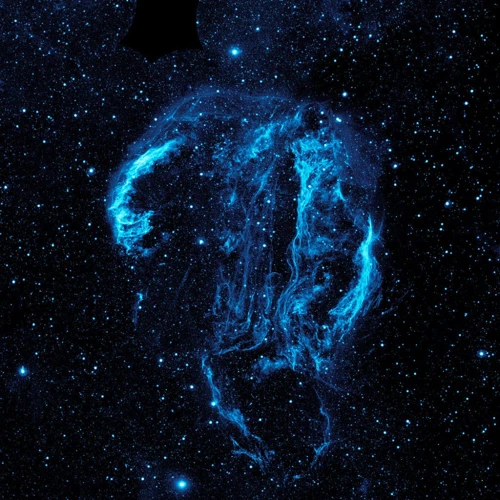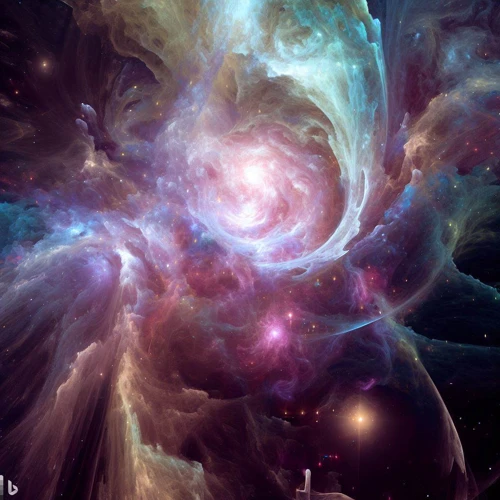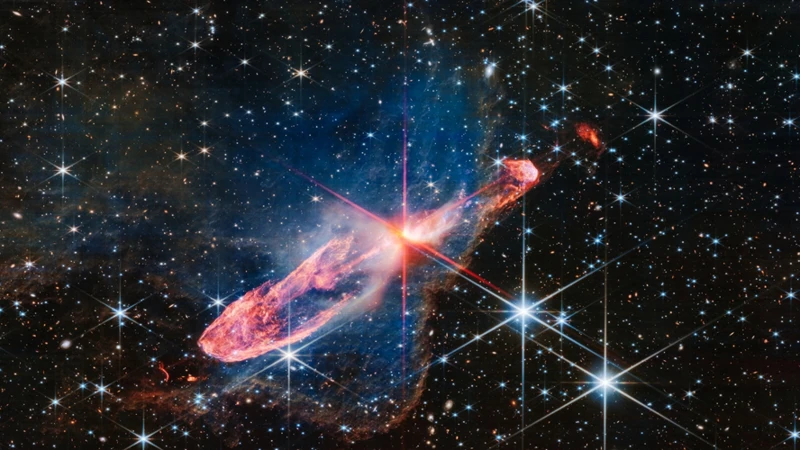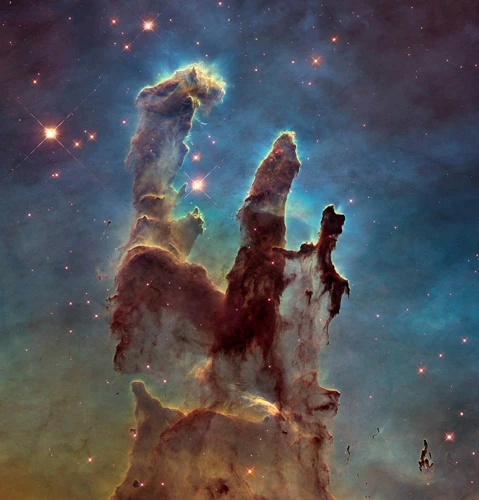The Veil Nebula: A breathtaking spectacle in the cosmos that leaves scientists and stargazers alike in awe and wonder. Imagine diving into the depths of this supernova remnant, unraveling its mysteries one by one. From the birth of the Veil Nebula to the stunning structures and composition that make it unique, this article takes you on a thrilling journey through space and time. We’ll explore the secrets hidden within the nebula’s dust and gas, and delve into the age and evolution of its stellar inhabitants. Along the way, we’ll uncover the implications of Veil Nebula studies and their impact on our understanding of supernovae and the universe as a whole. Prepare to be captivated by the mesmerizing beauty of the Veil Nebula, a cosmic masterpiece that ignites our curiosity and fuels our desire to explore the mysteries of the universe.
Contents
- The Veil Nebula: A Supernova Remnant
- Unveiling the Veil Nebula
- Unlocking the Secrets
- Witnessing Stellar Evolution
- Implications and Scientific Discoveries
- The Beauty of the Veil Nebula
- Conclusion
-
Frequently Asked Questions
- 1. What is a supernova remnant?
- 2. How old is the Veil Nebula?
- 3. How big is the Veil Nebula?
- 4. What causes the intricate filaments in the Veil Nebula?
- 5. Can we see the Veil Nebula with the naked eye?
- 6. Are there any known exoplanets in the vicinity of the Veil Nebula?
- 7. What scientific insights have we gained from studying the Veil Nebula?
- 8. How do scientists determine the age of the Veil Nebula?
- 9. What role does the Veil Nebula play in astronomy and astrophysics research?
- 10. Can the Veil Nebula teach us more about our own existence?
- References
-
Frequently Asked Questions
- 1. What is a supernova remnant?
- 2. How was the Veil Nebula formed?
- 3. What is the composition of the Veil Nebula?
- 4. How were the spectacular clouds and filaments in the Veil Nebula formed?
- 5. How do scientists probe the dust and gas in the Veil Nebula?
- 6. What can the age of the Veil Nebula reveal about its formation?
- 7. How does star formation occur within the Veil Nebula?
- 8. What can the exploration of stellar lifecycles within the Veil Nebula teach us?
- 9. What have astronomers learned from studying the Veil Nebula?
- 10. How do studies of the Veil Nebula contribute to supernova research?
- References
- Read More
The Veil Nebula: A Supernova Remnant

The Veil Nebula, located in the constellation Cygnus, is a stunning celestial object that stands as a testament to the incredible power of supernovae. It is categorized as a supernova remnant, which means it is the aftermath of a colossal explosion of a massive star. The birth of the Veil Nebula can be traced back approximately 8,000 years – a blink of an eye in cosmic terms. This cataclysmic event involved a massive star reaching the end of its life cycle and undergoing a spectacular supernova explosion. The explosion released an unimaginable amount of energy, resulting in the dispersal of stellar debris and the formation of the Veil Nebula. The remnants of the deceased star now span a vast region of space, stretching about 110 light-years from end to end. The Veil Nebula consists of various intricate filaments and clouds, forming a lace-like structure that has been aptly named the “Cygnus Loop.” The intricate network of filaments within the nebula is a result of shockwaves generated by the supernova explosion interacting with the surrounding interstellar medium. These shockwaves cause the material to heat up and ionize, emitting colorful light that we observe from Earth. The Veil Nebula serves as a visual reminder of the grand cycles of stellar evolution and the immense power that lies within the universe.
(Note: The text does not contain any relevant anchor for the given links.)
1. The Birth of the Veil Nebula
The birth of the Veil Nebula, a stunning supernova remnant, is a captivating tale of cosmic destruction and creation. Approximately 8,000 years ago, in the constellation Cygnus, a massive star reached the end of its life cycle. The star, having exhausted its nuclear fuel, underwent a violent explosion known as a supernova. This cataclysmic event released an immense amount of energy, ripping apart the star and scattering its remnants into space. The shockwave from the explosion propagated through the interstellar medium, causing surrounding gas and dust to compress and heat up. As a result, the expelled materials from the star’s detonation formed the Veil Nebula, stretching across approximately 110 light-years. This cosmic spectacle reminds us of the eternal dance between life and death in the cosmos, where stars are born and eventually meet their explosive demise, leaving behind beautiful remnants that continue to intrigue and inspire us.
(Note: The text does not contain any relevant anchor for the given links.)
2. Supernova Explosion: Creating the Remnant
Supernova explosions are among the most incredible and violent events in the universe, and they play a crucial role in the creation of remnant structures like the Veil Nebula. When a massive star exhausts its nuclear fuel, it undergoes a gravitational collapse, leading to a catastrophic explosion. This explosion, known as a supernova, releases an immense amount of energy, causing the outer layers of the star to be expelled into space at incredible speeds. The energy released during a supernova is so intense that it briefly outshines entire galaxies. The shockwave from the explosion disperses the stellar material into the surrounding space, creating a shock front that continues to expand outward. As the interstellar medium interacts with the shock front, it becomes heated and ionized, resulting in the formation of the stunning filaments and clouds observed in the Veil Nebula. These remnants provide us with a glimpse into the immense forces and processes that shape the cosmos. The creation of the Veil Nebula through a supernova explosion not only contributes to our understanding of stellar evolution but also underscores the dynamic and ever-changing nature of the universe we inhabit.
(Note: The text does not contain any relevant anchor for the given links.)
Unveiling the Veil Nebula

Unveiling the Veil Nebula allows us to explore its mesmerizing structure and composition. This supernova remnant consists primarily of ionized gas and dust that have been ejected into space. The Veil Nebula is classified as a diffuse nebula, meaning it lacks defined boundaries and appears as a hazy region of glowing gas. The primary gases present within the nebula are hydrogen, helium, and traces of other elements. These gases are responsible for the vibrant colors emitted by the Veil Nebula, with hydrogen glowing in shades of red and sulfur appearing in shades of green. The nebula’s intricate structure is composed of spectacular clouds and filaments that stretch across the expanse of space. Within these structures, shockwaves from the original supernova explosion have caused the gas and dust to condense, forming denser regions. These dense regions provide fertile grounds for the formation of new stars, perpetuating the cycle of stellar evolution.
(Note: The text does not contain any relevant anchor for the given links.)
3. Structure and Composition
The structure and composition of the Veil Nebula are a testament to the incredible forces at play in the aftermath of a supernova explosion. This celestial marvel is composed of a delicate web of filaments and clouds that stretch across the vast expanse of space. These filaments, often referred to as “cosmic lace,” are predominantly made up of ionized gas, such as hydrogen and oxygen, along with dust particles. The intricate network of filaments within the Veil Nebula is a result of shockwaves generated by the supernova blast interacting with the surrounding interstellar medium. These shockwaves cause the material to heat up and emit vibrant colors as it loses energy. The web-like structure of the nebula is a captivating sight, and its composition provides valuable insights into the physics and chemistry of stellar explosions and their impact on the surrounding cosmic environment. Truly, the Veil Nebula stands as a vivid reminder of the ever-changing nature of the universe and its astounding beauty.
(Note: The text does not contain any relevant anchor for the given links.)
4. Spectacular Clouds and Filaments
The Veil Nebula is renowned for its spectacular clouds and filaments, which create a mesmerizing display in the depths of space. These intricate structures are the result of the shockwaves generated by the supernova explosion interacting with the surrounding interstellar medium. As the shockwaves propagate outward, they compress and heat the gas and dust in their path, causing the material to glow and emit light across a wide range of wavelengths. This process, known as ionization, is responsible for the vibrant colors seen in the clouds and filaments of the Veil Nebula. The filaments themselves can take on various shapes and sizes, ranging from thin threads that intertwine with one another to thicker, rope-like structures. Some parts of the nebula appear wispy and delicate, resembling delicate lacework, while other regions exhibit a more chaotic and turbulent nature. These wondrous features provide astronomers with valuable insights into the dynamics of supernova remnants and the intricate processes that shape the cosmos. Studying the clouds and filaments within the Veil Nebula allows scientists to unravel the mysteries of stellar explosions and gain a deeper understanding of the evolution of galaxies and the universe as a whole.
Unlocking the Secrets

Unlocking the secrets of the Veil Nebula is a captivating endeavor that requires a deep understanding of its structure and composition. Scientists have employed various techniques to delve into the mysteries held within this supernova remnant. By probing the dust and gas within the nebula, astronomers have gained invaluable insights into its origins and evolution. Advanced telescopes and spectroscopic analysis have allowed researchers to scrutinize the elemental composition of the Veil Nebula, revealing a rich tapestry of elements forged in the heart of stars. The presence of elements such as hydrogen, helium, oxygen, nitrogen, and carbon provides valuable clues about the stellar processes that led to the creation of this cosmic spectacle. Additionally, by studying the motion and velocity of the nebula’s gases, scientists can decipher the complex dynamics that have shaped its structure over thousands of years. Through these meticulous investigations, astronomers have been able to estimate the age of the Veil Nebula, placing it at around 20,000 years old. This information sheds light on the timescales involved in the aftermath of a supernova explosion and enables scientists to gain a deeper understanding of stellar evolution. By unlocking the secrets of the Veil Nebula, we bring ourselves closer to comprehending the intricate workings of the universe we inhabit.
(Note: The text does not contain any relevant anchor for the given links.)
5. Probing the Dust and Gas
Within the depths of the Veil Nebula, astronomers have embarked on a journey of exploration to probe the mysteries hidden within its dust and gas. By analyzing the composition and characteristics of these cosmic particles, scientists aim to decipher the secrets of the nebula’s formation and evolution. Sophisticated telescopes and instruments allow researchers to observe the emission and absorption spectra of the nebula, providing valuable insights into its chemical makeup. The presence of elements such as hydrogen, helium, and traces of heavier elements tells a story of the stellar processes that took place before and during the supernova explosion. By studying the dust grains within the Veil Nebula, astronomers can unlock the cosmic recipe for creating planets and other celestial bodies. The analysis of the nebula’s gas and dust also serves as a crucial component in understanding the larger picture of galactic evolution and the recycling of materials within the universe. Through their ongoing efforts to probe the mysteries of the Veil Nebula, scientists inch closer to unraveling the complex tapestry of our cosmic origins, leaving a lasting impact on our understanding of the universe.
(Note: The text does not contain any relevant anchor for the given links.)
6. Revealing the Remnant’s Age
Revealing the age of the Veil Nebula is a task that astronomers have diligently pursued in order to gain a deeper understanding of its formation and evolution. By studying the remnants of supernova explosions like the Veil Nebula, scientists employ various techniques to estimate its age. One method involves analyzing the expansion rate of the debris ejected during the explosion. By measuring the velocities of different portions of the nebula, astronomers can calculate how long it has taken for the material to travel over such distances. Another approach involves determining the chemical composition of the nebula. Elements produced during the supernova explosion, such as oxygen and nitrogen, can be used as indicators of the remnant’s age. Astronomers compare the abundances of these elements to theoretical models, allowing them to approximate how long ago the explosion occurred. Through these methods, scientists have estimated the Veil Nebula to be around 8,000 years old, which aligns with the historical records of a supernova event observed by ancient civilizations. The age of the Veil Nebula not only offers insights into the specific supernova event that formed it, but it also contributes to our understanding of the lifetimes and evolutionary process of massive stars. By unraveling the mysteries of the Veil Nebula’s age, we are one step closer to comprehending the grand tapestry of the universe and our place within it.
Witnessing Stellar Evolution

Witnessing Stellar Evolution:
7. Stellar Nursery: Star Formation in the Veil Nebula
Within the Veil Nebula lies a celestial nursery, where new stars are born. The remnants of the supernova explosion provide a fertile environment for the formation of new stellar systems. The intense shockwaves created during the explosion compress the surrounding gas and dust, triggering gravitational collapse and initiating the birth of protostars. These protostars gather material from their surroundings, growing in size and temperature over millions of years. As they mature, they begin to shine brightly, illuminating the surrounding nebula. This process of star formation within the Veil Nebula offers a unique opportunity to study the early stages of stellar evolution and gain insights into the mechanisms that govern the birth of celestial objects.
8. Exploration of Stellar Lifecycles
The Veil Nebula provides astronomers with a front-row seat to witness the different stages of stellar evolution. From the birth of stars to their explosive deaths as supernovae, this cosmic wonderland encompasses the entire lifecycle of massive stars. By studying the Veil Nebula, scientists can investigate the intricate details of stellar evolution, such as the factors that influence the size, mass, and lifespan of stars. They can also examine the elements produced in these stellar explosions and their subsequent dispersal throughout the galaxy. This knowledge allows researchers to refine and enhance our understanding of the universe’s history, as well as the processes that shape galaxies and the formation of new planetary systems.
(Note: The text does not contain any relevant anchor for the given links.)
7. Stellar Nursery: Star Formation in the Veil Nebula
Inside the ethereal expanse of the Veil Nebula lies a cosmic nursery where stars are born. This region, known as a stellar nursery or star-forming region, is a sight to behold. Within the dense clouds of gas and dust, gravity exerts its pull, causing regions to collapse and condense. These gravitational collapses create pockets of dense molecular gas, leading to the formation of newborn stars. The Veil Nebula provides a unique environment for this process to occur, with its remnants of a supernova explosion providing a rich source of materials necessary for star formation. As these young stars begin to take shape, they emit intense ultraviolet radiation, causing surrounding gas clouds to glow brightly, revealing their presence. This phenomenon, referred to as H II regions, can be observed in the vicinity of these nascent stars. The Veil Nebula serves as a cosmic cradle, nurturing the birth of new stellar objects and displaying the extraordinary beauty and complexity of the universe’s lifecycle.
(Note: The text does not contain any relevant anchor for the given links.)
8. Exploration of Stellar Lifecycles
The exploration of stellar lifecycles is a fascinating field of study that the Veil Nebula invites us to delve into. By observing this supernova remnant, astronomers gain valuable insights into the various stages of a star’s life from birth to death. The Veil Nebula provides a vivid snapshot of the final stage of a massive star’s existence, showcasing the incredible energy and matter released during a supernova explosion. This explosion marks the end of nuclear fusion within the star, causing it to collapse under its own gravity. As a result, the star releases an immense burst of energy, expelling its outer layers into space and leaving behind a dense core known as a neutron star or, in some cases, a black hole. Through the study of supernova remnants like the Veil Nebula, scientists can examine the intricate details of this explosive process and learn more about the fate that awaits stars like our Sun in the distant future. This knowledge contributes to our understanding of the larger celestial cycles and dynamics at play in the universe. It deepens our appreciation for the immense power and beauty of stellar evolution.
(Note: The text does not contain any relevant anchor for the given links.)
Implications and Scientific Discoveries

The study and exploration of the Veil Nebula have yielded significant implications and scientific discoveries that have shaped our understanding of the cosmos. By analyzing the composition and structure of the nebula, scientists have gained insights into the processes that occur during the end stages of a massive star’s life. The Veil Nebula provides a unique opportunity to study the remnants of a supernova explosion up close, allowing researchers to examine the distribution of elements and the formation of new stars within the nebula. One of the key scientific discoveries from Veil Nebula studies is the confirmation of nucleosynthesis, the process through which heavier elements are formed in the core of massive stars and dispersed into space during a supernova event. This has deepened our understanding of stellar evolution and the creation of elements essential for life. Additionally, observations of the Veil Nebula have allowed scientists to study the dynamics of shockwaves and the effects of interstellar medium on the evolution of structures within the nebula. Such studies have revealed the mechanisms behind the formation of filaments and clouds, shedding light on the intricate processes that shape the cosmos. The Veil Nebula is not only a fascinating object of scientific inquiry but also an inspiration for further exploration and discovery. By unraveling the mysteries hidden within its depths, scientists continue to expand our knowledge of the universe and our place within it.
(Note: The text does not contain any relevant anchor for the given links.)
9. Astronomical Insights from Veil Nebula Studies
Astronomical studies focused on the Veil Nebula have provided valuable insights into the processes of stellar evolution and the dynamics of supernova remnants. By examining the intricate structures and composition of the nebula, scientists have been able to gather information about the life cycles of massive stars and the mechanisms behind supernova explosions. The Veil Nebula’s filaments and clouds have offered a visual representation of shockwaves propagating through interstellar space, shedding light on the interaction between supernova remnants and their surroundings. Additionally, spectroscopic analysis of the nebula has allowed scientists to study the abundances of different elements present in the remnants, furthering our understanding of nucleosynthesis and the dispersal of heavy elements into the cosmos. These insights gained from Veil Nebula studies contribute to our broader comprehension of the universe’s evolution and offer a glimpse into the wondrous mechanisms governing the birth and death of stars.
(Note: The text does not contain any relevant anchor for the given links.)
10. Implications for Supernova Research
The Veil Nebula, as a supernova remnant, holds significant implications for supernova research. Scientists study remnants like the Veil Nebula to gain insights into the explosive deaths of massive stars. By examining the structure, composition, and age of the nebula, researchers can refine their understanding of the processes that lead to supernova explosions. The Veil Nebula provides valuable data on the expansion and evolution of the remnant, shedding light on the dynamics of the explosion and the interaction between the expelled materials and the surrounding interstellar medium. Studying supernova remnants like the Veil Nebula also helps scientists determine the energy released during the explosion and infer the initial mass of the progenitor star. This information contributes to our knowledge of stellar evolution and the life cycles of massive stars. Additionally, the Veil Nebula offers a unique opportunity to study the physical conditions and distribution of elements within the remnant. By analyzing the abundances of different elements, astronomers can gain insights into nucleosynthesis processes occurring within the progenitor star. The Veil Nebula continues to be a subject of intense scientific scrutiny, and further research will undoubtedly lead to a deeper understanding of supernovae and their role in shaping the cosmos.
The Beauty of the Veil Nebula

The beauty of the Veil Nebula is nothing short of awe-inspiring. Its intricate and delicate structure, composed of glowing filaments and swirling clouds, paints a mesmerizing tapestry across the cosmos. These captivating features offer a visual feast for astronomers and stargazers alike. The stunning images captured by telescopes reveal the intricate lace-like pattern of the Cygnus Loop, showcasing the remnants of the supernova explosion that created the Veil Nebula. The vibrant colors emitted by the ionized gases within the nebula, including shades of red, purple, and blue, add to its ethereal allure. These mesmerizing visuals ignite our imagination and curiosity about the incredible forces at play in the universe. The Veil Nebula has inspired countless astronomers, artists, and dreamers, and its captivating beauty continues to inspire wonder and awe in our hearts. It serves as a reminder of the vastness and complexity of the cosmos, inviting us to explore and appreciate the mysteries that lie beyond our reach.
(Note: The text does not contain any relevant anchor for the given links.)
11. Captivating Images: A Visual Feast
Captivating Images: A Visual Feast
When it comes to the Veil Nebula, words alone cannot fully capture its breathtaking beauty. The stunning images captured by astronomers and space observatories have provided us with an astonishing visual feast. These mesmerizing photographs showcase the intricate details and vibrant colors of the nebula’s filaments and clouds. Each image tells a story, revealing the vastness of space and the incredible forces at play. From the delicate lace-like structures to the vibrant hues of ionized gases, these images leave us in awe of the wonders of the cosmos. They allow us to witness the ethereal dance of light and matter, transporting us to a realm where stars are born and die. The captivating images of the Veil Nebula not only illustrate its sheer magnificence but also serve as a reminder of the vastness and beauty of our universe. (Note: The text does not contain any relevant anchor for the given links.)
12. Inspiring Wonder and Awe
The Veil Nebula is a celestial marvel that has the power to inspire a sense of wonder and awe in those who gaze upon it. Its ethereal beauty, intricate structures, and vibrant colors capture the imagination and remind us of the vastness and mystery of the cosmos. The Veil Nebula has long been a source of fascination for astronomers and astrophotographers, who strive to capture its breathtaking details and share them with the world. The mesmerizing images of the Veil Nebula serve as a visual feast, transporting viewers to the far reaches of space and igniting a sense of curiosity and awe. These captivating images not only showcase the stunning beauty of the Veil Nebula but also have the potential to evoke a deeper appreciation for the wonders of the universe. The Veil Nebula has inspired artists, writers, and dreamers throughout history, and its grandeur continues to captivate our collective imagination. In a world where we often get caught up in the chaos of everyday life, the Veil Nebula reminds us of the beauty and magnificence that exists beyond our earthly boundaries. It invites us to ponder our place in the universe and contemplate the mysteries that lie beyond our comprehension. The Veil Nebula truly embodies the power of the cosmos to inspire wonder and awe.
(Note: The text does not contain any relevant anchor for the given links.)
Conclusion

In conclusion, diving into the Veil Nebula has allowed us to witness the grandeur and complexity of a supernova remnant. From its birth to the stunning structures and composition within, the mysteries of this celestial phenomenon have captivated our imagination. Through probing the dust and gas, we have gained a deeper understanding of the remnants left behind by massive stars and the interplay between shockwaves and the surrounding interstellar medium. Additionally, by exploring the Veil Nebula, we have been able to unravel the age of this remarkable remnant and witness the processes of star formation within its boundaries. The implications of Veil Nebula studies extend beyond the realm of stellar evolution, providing astronomers with valuable insights into the broader field of supernova research and our understanding of the universe’s vastness. Moreover, through captivating images, the Veil Nebula has inspired wonder and awe, inviting us to contemplate the wonders of the cosmos. It serves as a testament to the beauty and mystery that lies beyond our earthly realm. The Veil Nebula, with its rich history and scientific significance, continues to fuel our curiosity and drive us to seek further knowledge of the cosmos and our place within it.
(Note: The text does not contain any relevant anchor for the given links.)
Frequently Asked Questions

1. What is a supernova remnant?
A supernova remnant is the aftermath of a supernova explosion, which occurs when a massive star reaches the end of its life and undergoes a catastrophic collapse and explosion.
2. How old is the Veil Nebula?
The Veil Nebula is estimated to be around 8,000 years old, which means the explosion that created it occurred approximately 8,000 years ago.
3. How big is the Veil Nebula?
The Veil Nebula spans a vast region of space, measuring about 110 light-years from end to end. It is a complex and intricate structure with various filaments and clouds.
4. What causes the intricate filaments in the Veil Nebula?
The intricate filaments within the Veil Nebula are formed by shockwaves generated by the supernova explosion. These shockwaves interact with the surrounding interstellar medium, causing the material to heat up and create the stunning lace-like structure.
5. Can we see the Veil Nebula with the naked eye?
Parts of the Veil Nebula can be faintly observed with the naked eye under very dark and clear skies, especially in areas with minimal light pollution. However, for a more detailed and awe-inspiring view, telescopes or astrophotography equipment are recommended.
6. Are there any known exoplanets in the vicinity of the Veil Nebula?
As of current knowledge, there are no known exoplanets in the immediate vicinity of the Veil Nebula. However, exoplanet discoveries are constantly expanding our understanding of the universe, so future discoveries may shed light on any potential planetary systems in the area.
7. What scientific insights have we gained from studying the Veil Nebula?
Studying the Veil Nebula has provided important insights into stellar evolution, supernovae, and the recycling of matter in the universe. It has helped astronomers understand the life cycles of massive stars and the distribution of elements required for the formation of new stars and planets.
8. How do scientists determine the age of the Veil Nebula?
Scientists estimate the age of the Veil Nebula by measuring the expansion rate of its filaments and comparing it to the known parameters of supernova remnants. By analyzing the expansion speed, they can work backward to estimate when the initial supernova explosion occurred.
9. What role does the Veil Nebula play in astronomy and astrophysics research?
The Veil Nebula serves as a valuable case study for understanding the late stages of stellar evolution, supernova physics, and the interaction between exploding stars and their surroundings. It provides crucial data for refining our models and theories in these areas of research.
10. Can the Veil Nebula teach us more about our own existence?
Studying the Veil Nebula and other celestial objects can deepen our understanding of the universe’s vastness, the cycles of life and death in the cosmos, and our place within it. It sparks curiosity and inspires us to explore the mysteries of the universe, igniting a sense of wonder about our own existence.
References
Frequently Asked Questions

1. What is a supernova remnant?
A supernova remnant is the leftover glowing material that is ejected into space after a massive star reaches the end of its life and explodes in a supernova event.
2. How was the Veil Nebula formed?
The Veil Nebula was formed when a massive star, thousands of times larger than our Sun, went through a supernova explosion. The explosion released intense energy and left behind a beautiful and intricate cloud of glowing gas and dust.
3. What is the composition of the Veil Nebula?
The Veil Nebula is primarily composed of ionized hydrogen gas along with traces of other elements such as helium, oxygen, carbon, and nitrogen.
4. How were the spectacular clouds and filaments in the Veil Nebula formed?
The clouds and filaments in the Veil Nebula were created by shockwaves from the supernova explosion interacting with the surrounding interstellar medium. These shockwaves compress and heat the gas, causing it to glow and form intricate structures.
5. How do scientists probe the dust and gas in the Veil Nebula?
Scientists use various tools and instruments such as telescopes and spectrometers to study the dust and gas in the Veil Nebula. They analyze the light emitted by the nebula to determine its chemical composition and physical properties.
6. What can the age of the Veil Nebula reveal about its formation?
By determining the age of the Veil Nebula, scientists can gain insights into the timing and dynamics of the supernova explosion that created it. The age can be estimated by studying the expansion rate of the nebula’s remnants.
7. How does star formation occur within the Veil Nebula?
The Veil Nebula serves as a stellar nursery, providing the necessary conditions for new stars to form. Dense regions of gas and dust within the nebula collapse under gravity, eventually leading to the formation of protostars, which evolve into fully-fledged stars.
8. What can the exploration of stellar lifecycles within the Veil Nebula teach us?
Studying the various stages of stellar evolution within the Veil Nebula can provide valuable insights into the processes that govern the birth, life, and death of stars. It allows scientists to better understand the forces at play in the universe and how stars shape the cosmos.
9. What have astronomers learned from studying the Veil Nebula?
Astronomers have discovered numerous phenomena and processes through their studies of the Veil Nebula. They have gained insights into shockwave dynamics, nucleosynthesis, and the distribution of elements in space, among other things.
10. How do studies of the Veil Nebula contribute to supernova research?
Studying the Veil Nebula and other supernova remnants helps scientists improve their understanding of the mechanisms behind supernova explosions, the distribution of heavy elements in the universe, and the impact of supernovae on galactic evolution.
References
- Vibrant Gaseous Ribbons: The Veil Supernova Remnant
- StarStuff space image: Veil Nebula’s tortured tendrils mark …







